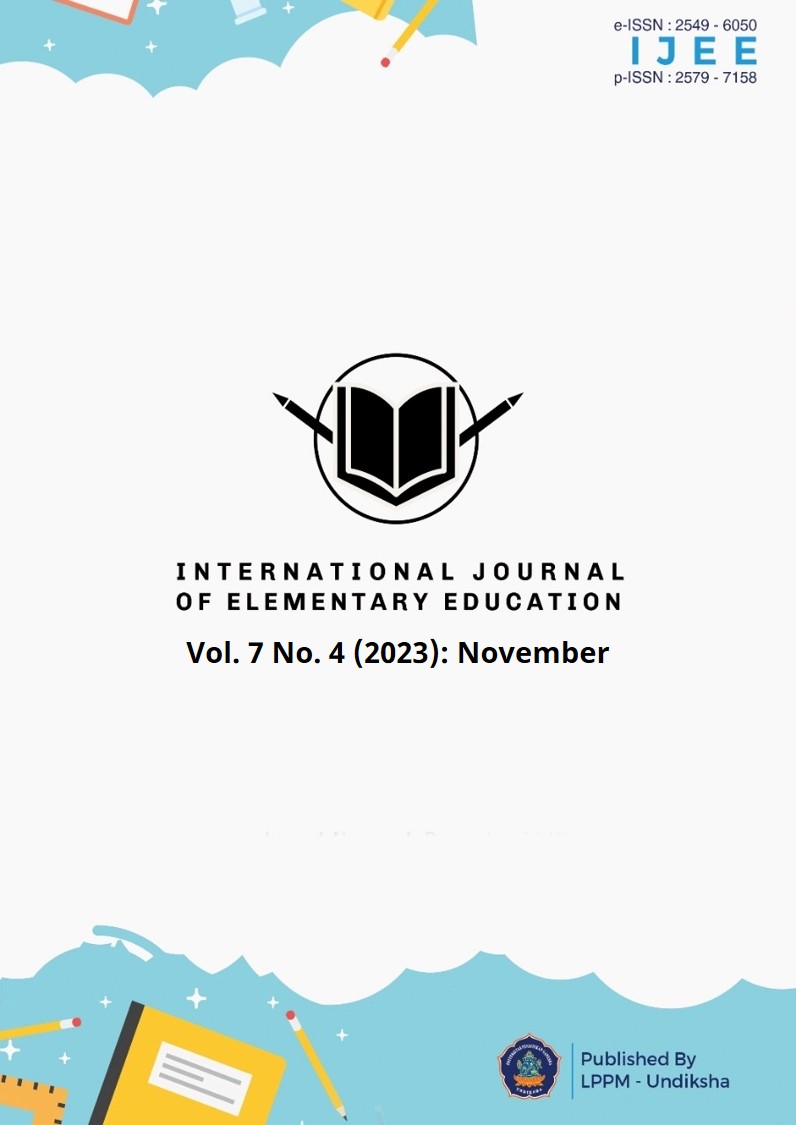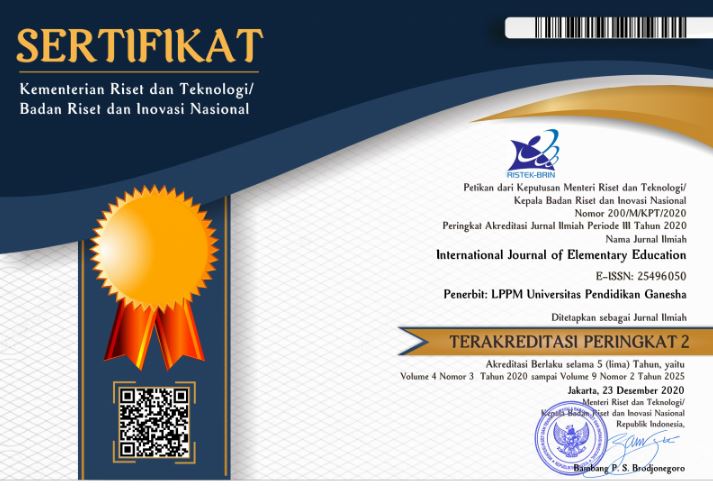Envisioning Future Elementary School Teachers’ Practices in The Post-Pandemic Era: A Visual Narrative Inquiry
DOI:
https://doi.org/10.23887/ijee.v7i4.54164Keywords:
Pre-service elementary school teachers, post-COVID-19 pandemic, visual narrative inquiryAbstract
The COVID-19 pandemic has revolutionised the educational landscape massively, including the way teachers enact their roles both inside and outside the classroom context. The abrupt changes also influence pre-service teachers’ way of envisioning themselves as future teachers in the post-pandemic era. The aims of this study is to analyze the underlying influences and concerns for their choice of future projection as post-pandemic elementary school teachers. This study using the photo-narrative frame construct of visual narrative inquiry, this study explored the way three first-year pre-service elementary school teachers imagined their. The data were collected from students’ self-portraits and written narratives narrating their past, current, and future projection as post-pandemic teachers. The multimodal narrative analysis was applied to analyse both the visual and written narratives. The findings suggest that technology integration and student-centred pedagogy became the most common themes when the pre-service teachers projected their future selves. At the same time, their previous schooling experiences and future concerns about becoming a teacher had certain impacts on the way they projected themselves as future teachers. Therefore, it is recommended that future pre-service teachers should be given opportunities to reflect on their previous teaching and learning experiences and project what they wish to emulate and enhance for their future teaching practices.
References
Ahn, S. Y. (2021). Visualizing the interplay of fear and desire in English learner’s imagined identities and communities. System, 102, 1–12. https://doi.org/10.1016/j.system.2021.102598. DOI: https://doi.org/10.1016/j.system.2021.102598
Anspal, T., Eisenschmidt, E., & Löfström, E. (2012). Finding myself as a teacher: Exploring the shaping of teacher identities through student teachers narratives. Teachers and Teaching: Theory and Practice, 18(2), 197–216. https://doi.org/10.1080/13540602.2012.632268. DOI: https://doi.org/10.1080/13540602.2012.632268
Atmojo, A. E. P., & Nugroho, A. (2020). EFL Classes Must Go Online! Teaching Activities and Challenges during COVID-19 Pandemic in Indonesia. Register Journal, 13(1), 49–76. https://doi.org/10.18326/rgt.v13i1.49-76. DOI: https://doi.org/10.18326/rgt.v13i1.49-76
Barbarroja, M. G. (2022). Exploring modern language teachers’ professional identity through visual self-representations of professional lifelong journeys. In K. Sadeghi & F. Ghaderi (Eds.), Theory and practice in second language teacher identity: Researching, theorising and enacting (pp. 243–262). Springer. https://link.springer.com/chapter/10.1007/978-3-031-13161-5_17. DOI: https://doi.org/10.1007/978-3-031-13161-5_17
Barkhuizen, G., & Consoli, S. (2021). Pushing the edge in narrative inquiry. System, 102, 1–9. https://doi.org/10.1016/J.SYSTEM.2021.102656. DOI: https://doi.org/10.1016/j.system.2021.102656
Beauchamp, C., & Thomas, L. (2010). Reflecting on an ideal: Student teachers envision a future identity. Reflective Practice: International and Multidisciplinary Perspectives, 11(5), 631–643. https://doi.org/10.1080/14623943.2010.516975. DOI: https://doi.org/10.1080/14623943.2010.516975
Beltman, S., Glass, C., Dinham, J., Chalk, B., & Nguyen, B. (2015). Drawing identity: Beginning pre-service teachers’ professional identities. Issues in Educational Research, 25(3), 225–245. https://search.informit.org/doi/abs/10.3316/informit.535515724376399.
Bhattacharya, K. (2017). Fundamentals of qualitative research: A practical guide. Routledge. DOI: https://doi.org/10.4324/9781315231747
Blackledge, D., & Hunt, B. (2017). Sociological interpretations of education. Routledge.
Blackley, S., Bennett, D., & Sheffield, R. (2018). Pre-service teachers’ articulation of their future selves. Issues in Educational Research, 28(4), 849–869. https://search.informit.org/doi/abs/10.3316/INFORMIT.022309371412652.
Boulton, A., Grauer, K., & L. Irwin, R. (2017). Becoming teacher: A/r/tographical inquiry and visualising metaphor. International Journal of Art and Design Education, 36(2), 200–214. https://doi.org/10.1111/jade.12080. DOI: https://doi.org/10.1111/jade.12080
Caine, V., Estefan, A., & Clandinin, D. J. (2013). A return to methodological commitment: Reflections on narrative inquiry. Scandinavian Journal of Educational Research, 57(6), 574–586. https://doi.org/10.1080/00313831.2013.798833. DOI: https://doi.org/10.1080/00313831.2013.798833
Callingham, R., & Watson, J. M. (2017). The development of statistical literacy at school. Statistics Education Research Journal, 16(1), 181–201. https://doi.org/10.52041/serj.v16i1.223. DOI: https://doi.org/10.52041/serj.v16i1.223
Chang-Kredl, S., & Kingsley, S. (2014). Identity expectations in early childhood teacher education: Pre-service teachers’ memories of prior experiences and reasons for entry into the profession. Teaching and Teacher Education, 43, 27–36. https://doi.org/10.1016/j.tate.2014.05.005. DOI: https://doi.org/10.1016/j.tate.2014.05.005
Creswell, J. W. (2012). Educational research planning, conducting, and evaluating quantitative and qualitative research (4th ed). MA: Pearson.
Darling-Hammond, L. (2014). Strengthening clinical preparation: The holy grail of teacher education. Peabody Journal of Education, 89(4), 547–561. https://doi.org/10.1080/0161956X.2014.939009. DOI: https://doi.org/10.1080/0161956X.2014.939009
Dinham, J., Chalk, B., Beltman, S., Glass, C., & Nguyen, B. (2017). Pathways to resilience: How drawings reveal pre-service teachers’ core narratives underpinning their future teacher-selves. Asia-Pacific Journal of Teacher Education, 45(2), 126–144. https://doi.org/10.1080/1359866X.2016.1204424. DOI: https://doi.org/10.1080/1359866X.2016.1204424
Ekowati, D. W., & Suwandayani, B. I. (2021). Learning from home strategies in private elementary schools during Covid-19 pandemic. International Journal of Elementary Education, 5(3), 375–383. https://doi.org/10.23887/ijee.v5i3.33548. DOI: https://doi.org/10.23887/ijee.v5i3.33548
Everett, M. C. (2017). Fostering first-year students’ engagement and well-being through visual narratives. Studies in Higher Education, 42(4), 623–635. https://doi.org/10.1080/03075079.2015.1064387. DOI: https://doi.org/10.1080/03075079.2015.1064387
Fluck, A., & Dowden, T. (2011). On the cusp of change: Examining pre-service teachers’ beliefs about ICT and envisioning the digital classroom of the future. Journal of Computer Assisted Learning, 29(1), 1–10. https://doi.org/10.1111/j.1365-2729.2011.00464.x. DOI: https://doi.org/10.1111/j.1365-2729.2011.00464.x
Gavaldon, G., & McGarr, O. (2019). Exploring pre-service teachers’ future intentions to use technology through the use of comics. Teaching and Teacher Education, 83, 99–109. https://doi.org/10.1016/J.TATE.2019.04.004. DOI: https://doi.org/10.1016/j.tate.2019.04.004
Greenier, V., & Moodie, I. (2021). Photo-narrative frames: Using visuals with narrative research in applied linguistics. System, 102(July), 102597. https://doi.org/10.1016/j.system.2021.102597. DOI: https://doi.org/10.1016/j.system.2021.102597
Hahl, K. (2021). Student teachers’ experiences of using photos in teacher reflection. Reflective Practice, 22(1), 115–127. https://doi.org/10.1080/14623943.2020.1854212. DOI: https://doi.org/10.1080/14623943.2020.1854212
Imaduddin, M., Zuhaida, A., & Hidayah, F. F. (2019). Pre-service science teachers’ images about their past and future classrooms: Scratches from Indonesian teacher training program at Islamic University. Journal for the Education of Gifted Young Scientists, 7(3), 459–480. https://doi.org/10.17478/jegys.549257. DOI: https://doi.org/10.17478/jegys.549257
Johnson, G. C. (2001). Accounting for pre-service teachers’ use of visual metaphors in narratives. Teacher Development, 5(1), 119–140. https://doi.org/10.1080/13664530100200130. DOI: https://doi.org/10.1080/13664530100200130
Khosiyono, B. H. C. (2022). Teachers’ experiences of online learning at Indonesian elementary school during the covid-19 pandemic. International Journal of Elementary Education, 6(1), 127–133. https://doi.org/10.23887/ijee.v6i1.
Kutsyuruba, B., Walker, K. D., Matheson, I. A., & Bosica, J. (2022). Early career teaching progression: Examining Canadian teachers’ experiences during their first five years in the profession. New Educator, 18(1–2), 1–26. https://doi.org/10.1080/1547688X.2021.1940406. DOI: https://doi.org/10.1080/1547688X.2021.1940406
Lai, K., & Hong, K. (2015). Technology use and learning characteristics of students in higher education: Do generational differences exist? British Journal of Educational Technology, 46(4), 725–738. https://doi.org/10.1111/bjet.12161. DOI: https://doi.org/10.1111/bjet.12161
Lin, E., Shi, Q., Wang, J., Zhang, S., & Hui, L. (2012). Initial motivations for teaching: Comparison between preservice teachers in the United States and China. Asia-Pacific Journal of Teacher Education, 40(3), 227–248. https://doi.org/10.1080/1359866X.2012.700047. DOI: https://doi.org/10.1080/1359866X.2012.700047
Lyngsnes, K. M. (2012). Embarking on the teaching journey: Pre-service teachers reflecting upon themselves as future teachers. World Journal of Education, 2(2), 2–9. https://doi.org/10.5430/wje.v2n2p2. DOI: https://doi.org/10.5430/wje.v2n2p2
Mahmud, Y. S. (2021). Online microteaching: A transformation of teaching practices in teacher education during the Covid-19 pandemic. In S. R. Murtiningsih, I. W. Lestari, & E. D. Hatmanto (Eds.), Best practices and research in ELT classrooms (pp. 113–122). Pustaka Ilmu.
Mahmud, Y. S., Pujiastuti, A., Fitria, R., & Lestari, D. E. (2021). Elementary school parents’ perspectives on online English language teaching during Covid-19 pandemic. International Journal of Elementary Education, 6(1), 85–96. https://doi.org/10.23887/ijee.v6i1.
Mateos-Moreno, D. (2022). Why (not) be a music teacher? Exploring pre-service music teachers’ sources of concern regarding their future profession. International Journal of Music Education, 40(4), 489–501. https://doi.org/10.1177/02557614211073138. DOI: https://doi.org/10.1177/02557614211073138
O’Donoghue, T. (2019). Planning your qualitative research thesis and project (2nd ed.). Routledge. DOI: https://doi.org/10.4324/9781351165563
Polkinghorne, D. E. (2007). Validity issues in narrative research. Qualitative Inquiry, 13(4), 471–486. https://doi.org/10.1177/1077800406297670. DOI: https://doi.org/10.1177/1077800406297670
Richardson, P. W., & Watt†, H. M. G. (2006). Who chooses teaching and why? Profiling characteristics and motivations across three Australian universities. Asia-Pacific Journal of Teacher Education, 34(1), 27–56. https://doi.org/10.1080/13598660500480290. DOI: https://doi.org/10.1080/13598660500480290
Rodrigues, L. de A. D., de Pietri, E., Sanchez, H. S., & Kuchah, K. (2018). The role of experienced teachers in the development of pre-service language teachers’ professional identity: Revisiting school memories and constructing future teacher selves. International Journal of Educational Research, 88, 146–155. https://doi.org/10.1016/J.IJER.2018.02.002. DOI: https://doi.org/10.1016/j.ijer.2018.02.002
Sanurdi, S., Syahril, Erizon, N., & Nabawi, R. A. (2020). Media Video Tutorial pada Pembelajaran Mata Diklat Bubut untuk SMK. VOMEK: Jurnal Vokasi Mekanika, 2(4), 80–87. https://doi.org/10.24036/vomek.v2i4.145. DOI: https://doi.org/10.24036/vomek.v2i4.145
Siburian, S. N. R., & Mahmud, Y. S. (2022). Primary school teacher’s perception of game-based learning in online learning: The advantages and challenges. IJECA (International Journal of Education and Curriculum Application), 5(2), 116–132. https://doi.org/10.31764/IJECA.V5I2.8694. DOI: https://doi.org/10.31764/ijeca.v5i2.8694
Sudewiputri, M. P., & Dewi, M. S. A. (2022). Teacher’s perspective: Implementation of online learning during the Covid-19 pandemic. International Journal of Elementary Education, 6(2), 333–340. https://doi.org/10.23887/IJEE.V6I2.46598.
Watt, H. M. G., & Richardson, P. W. (2007). Motivational factors influencing teaching as a career choice: Development and validation of the FIT-choice scale. Journal of Experimental Education, 75(3), 167–202. https://doi.org/10.3200/JEXE.75.3.167-202. DOI: https://doi.org/10.3200/JEXE.75.3.167-202
Downloads
Published
How to Cite
Issue
Section
License
Copyright (c) 2023 Yogi Saputra Mahmud

This work is licensed under a Creative Commons Attribution-ShareAlike 4.0 International License.
Authors who publish with the International Journal of Elementary Education agree to the following terms:
- Authors retain copyright and grant the journal the right of first publication with the work simultaneously licensed under a Creative Commons Attribution License (CC BY-SA 4.0) that allows others to share the work with an acknowledgment of the work's authorship and initial publication in this journal.
- Authors are able to enter into separate, additional contractual arrangements for the non-exclusive distribution of the journal's published version of the work (e.g., post it to an institutional repository or publish it in a book), with an acknowledgment of its initial publication in this journal.
- Authors are permitted and encouraged to post their work online (e.g., in institutional repositories or on their website) prior to and during the submission process, as it can lead to productive exchanges, as well as earlier and greater citation of published work. (See The Effect of Open Access)










